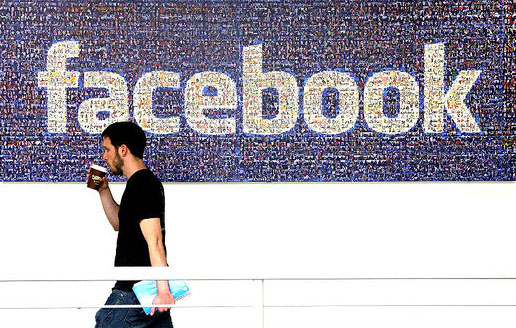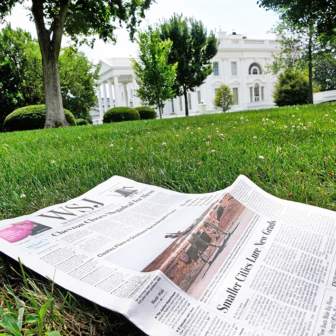First published May 2016
Downsizers must be a problem for the embattled newspaper industry. Late last year my husband and I sold our family house and bought a small apartment on the edge of the city, closer to my job. I imagined that I’d have more time to pore over the morning papers before rushing out the door, but no such luck: it proved totally impractical to have the newspaper delivered to our apartment building. So with a Proustian pang for the roll of crisp newsprint that used to wake me at 5.30 am as it hit the pot plants in the front yard, I rang and cancelled the Age subscription I had held since the days when I first worked for the paper, twenty-five years ago.
A pleasant woman in a call centre somewhere efficiently cancelled both the print edition and the digital replica on my iPad. I waited to see if she would offer me an incentive to keep the digital version. In former times, the sales rep would have produced a list of incentives to continue, but not this time. Near the end of our short conversation, she blandly observed that she would leave it to me to go online and purchase a new digital-only subscription, if I wanted one. And that was that. I felt more like the jilted than the jilter.
No doubt the Age already knew that in 2016 even rusted-on readers could contemplate with equanimity the idea of life without a daily paper. After all, it wasn’t just our household deserting. As the spring selling season rolled on, Facebook revealed old friends and former colleagues bailing out of suburban houses with big front yards and opting for townhouses and apartments. The same thing was happening in our old street. Around the time we put our house on the market, two lots of nearby neighbours also sold up, and the people across the road are about to join the exodus. Subscription departments must be inundated with telephone calls from vendors aged fifty-plus cashing in their housing stakes while Melbourne’s property boom lasts. It’s another nail in the coffin of print editions, at least on weekdays.
Last December rumours were rife among journalists and media academics that Fairfax would cease Monday-to-Friday print publication of its metropolitan dailies this year. Perhaps the 130,000 or so readers of the Age and Sydney Morning Herald still clinging to print-only subscriptions makes this a little less likely to happen very soon, but the prevalence and detail of these rumours (one SMH staffer even told me he knew who would be left in his section when the change finally came) attests to Fairfax’s digital immanence. With both print and digital advertising revenues falling, the company’s management must wish it could shed itself of the burden of producing and distributing the weekday papers for audience segments no larger than a couple of country towns.
Whenever daily delivery ends, it will be an enormous symbolic blow. The suburban home and the newspaper lying on its front lawn are entwined in twentieth-century iconography as the image of middle-class status and sociality. Yet the death of print is now old news, and other changes are having even deeper impacts on the state of newspapers and print media generally: developments in digital publishing, predicted for years, that are now well and truly upon us. They constitute a new paradigm for the media industries, but unlike the newspaper on the front lawn they are largely invisible, which has made them easier to ignore – and harder to understand.
For decades now we have been told that traditional media are push technologies, shoving their messages down our throats, and that the world wide web offers a democratic remedy. In the twenty-five years of the web this idea has thoroughly infiltrated our worldview. In politics, powered-up media consumers doing it for themselves were a key theme in former prime minister John Howard’s justification for loosening the cross-media ownership laws and abolishing the cap on foreign investment in Australian media. In e-commerce, Web entrepreneurs who have prospered through their understanding of market opportunities are everywhere, selling Australian infant formula to Chinese parents and online betting services to Aussie punters who once went down the road to the TAB.
In academia, the development of social network theory has helped instil the idea that every person or organisation that is part of the web starts equal, as a node in a potential network. In the media industries a blogger, a video-maker or a new social networking site have just as much chance of becoming a hub – a major convergence point in a network – as a celebrity journalist or a large media organisation does, perhaps even more. So it hurts the brain now to have to confront the bleeding obvious, that the internet was always potentially the biggest push medium of them all. Savvy observers like Michael Wolff and Tim Dunlop have been telling us this for quite a while but many of us haven’t been listening.
In 2010, in an article for Wired, Wolff observed the changes that venture capitalists were wreaking on the web through strategic investments in social networking sites: “The control the web took from the vertically integrated, top-down media world can, with a little rethinking of the nature and the use of the internet, be taken back.” This development, he wrote, was “perhaps the rudest shock possible to the leveled, porous, low-barrier-to-entry ethos of the Internet Age. After all, this is a battle that seemed fought and won.”
So far, the most visible disruption of the ever-expanding lacy pattern of social networks has arisen from the networks themselves, as Google and Facebook have shaken themselves free of hub shape and taken off in strong vertical trajectories, turning into major pillars of publishing and advertising, as well as important destinations for audiences. Their rise and rise has been assisted by mobile technology, especially smartphones and 4G networks.
Australians increasingly rely on mobile internet for social media and search, with 85 per cent of mobile users using their phones this way. About a quarter of young adults are exclusively mobile in terms of their primary access to telephony and the internet. This trend will only continue given the chronic economic uncertainty since the global financial crisis, which has transformed many of us into more efficient consumers reliant on our smartphones to discover and transact just-enough, just-in-time purchases.
Yet we empowered “social” consumers are also increasingly at the mercy of what our phone’s native apps and our favourite social media channels send us. We rely on social media updates and push notifications to find out what’s going on in the outside world or our own universe. And when we tap on a search engine result, like or share something on Facebook, review an item online, or even scroll to the end of a long article, we’re generating data about our personal preferences that is collected by the platform we’re using. This enables the platform to keep on sending us more of the same, not only articles our friends enjoyed, but also sponsored content and/or ads.
Facebook has led the way here, vigorously filtering what individual users see when they look at their own page or feed. “Our mission with News Feed is to connect people with the stories that matter most to them,” it says. The site ranks stories in our feed by looking at “thousands of factors relative to each person.” (Note the terminology of “News Feed” and “stories,” which aggrandises what for most of us is essentially a stream of posts from family and friends sharing favourite causes, dog or cat gifs, and snaps from last weekend’s barbecue.) Kurt Wagner, a social media expert at Re/code, says of Facebook and its founder, chairman and CEO Mark Zuckerberg, “They would never say that they are taking editorial control… they use an algorithm because Mark Zuckerberg doesn’t want to show you what you see, the algorithm does that.”
Still, Zuckerberg is kidding himself if he thinks that this is not just a twenty-first-century version of a traditional media model. The construction of Facebook’s News Feed has consequences for both our perception of what’s happening in the world and what information is available to us. To me, this sounds just like what old media has always being bashed up for doing – deciding what news we need, while growing rich on advertising. Facebook’s total revenues for 2015 were almost US$18 billion. In the final quarter alone, the company earned more than US$5 billion in advertising revenue, a 57 per cent increase year-on-year. This puts into perspective the continuing decline in digital ad revenue in major newspaper organisations such as Fairfax.
There is a strong correlation between the big increase in smartphone penetration and the surge in Facebook’s revenues. As the most popular social networking service in the world, Facebook reported it had 934 million active daily users on mobile by the end of 2015, an increase of 25 per cent year-on-year. The more we interact with our smartphones as consumers, the more social networking sites like Facebook prosper. As it makes clear in its online information, Facebook targets its ads based on “audience by user.” Facebookers don’t get a choice about whether ads appear in their feed. They can indicate their ad preferences, but that only helps Facebook to build a cleaner profile of them.
The more data an organisation collects about our personal details, tastes and purchases, the more power it has to deliver us ads we didn’t ask for about brands or activities we actually like (“have brand affinity for,” in the lingo). The individual with a smartphone clutched in his or her hand is the destination of the advertisement: the advertiser can dispense with the traditional “channels” that previously broadcast its ads to an undifferentiated mob of consumers. We become consumer-as-channel. If you’ve ever searched for tickets to a show or a holiday destination only to have the related advertising follow you around the rest of the day, you’ll know this is true.
It’s not only Facebook and Google Ads that are involved in this, although they set the pace. “Programmatic” advertising, as it’s known, increasingly dominates the way the advertising industry places ads, serving online ads to consumers. The most sophisticated programmatic exchanges are able to customise ad targeting in real time with a range of datasets, including anonymous user data. As Xaxis, an agency that specialises in programmatic advertising, explains, “The more anonymous data you have about a user, the more efficient you can be in your [ad] buying.”
Programmatic advertising is bad news for print media because it threatens newspaper ad models and also disconnects advertising from the editorial content that it was wrapped around. Some journalists say that content is still king. Some content marketers and search engine optimisation, or SEO, experts say it too. But what they mean is that some content is king. When a team of great journalists from around the globe combine to produce the #PanamaLeaks investigation showing how the rich and powerful use tax havens in South America and the Caribbean, then their stories are guaranteed to be interacted with endlessly and shared on social networking sites. But as journalists all know, while well-resourced investigative journalism is enjoying a field day, the humbler stuff – news we actually need, even if it will never set the world on fire, news that we used to read because it was under the page three or five lead – has been disconnected from the star stories. The traditional corpus of work that formed a newspaper’s identity is being shattered. Content that cannot market itself is dying, and so is the need to employ journalists to write it.
As Alan Kohler recently explained (in a penetrating article that everyone who cares about newspapers should read), the rapid decline in the dollar value of display advertising on news websites since the programmatic takeover has had a devastating impact on the economics of traditional news media. As he writes, “A journalist needs 200,000 clicks per day [on his or her stories] to pay for a salary of $100,000.”
So it’s no surprise that some of the best newspapers in the world are now using Facebook as a platform to build their reach, by publishing via its Instant Articles function and/or paying for ads and sponsored content. Instant Articles creates a direct feed from newspaper content management systems to the Facebook platform, enabling newspapers and magazines to quickly publish some of their best content on Facebook mobile, and saving Facebook users from the wait of several seconds it often takes to load links to newspaper sites. This gives the newspapers access to massive numbers of an increasingly impatient audience that doesn’t subscribe to the paper (and probably would not choose to). It also allows newspapers to feature within their Instant Articles advertising sold by their own sales teams, and then to backfill with Facebook’s own ad content. The Washington Post, the New York Times, the Atlantic, the Guardian and, in Australia, Fairfax Media were among early adopters. Apple has mounted a similar service via its News app, while Google has rolled out its Accelerated Mobile Pages service.
Will the Instant Articles experiment work for the mainstream press, injecting fresh audiences and increased ad revenue into their collapsed business model? Or is it a Trojan horse? A great risk is that venerable mastheads become glorified news agencies for bigger media players than themselves, while fatally blurring the prestigious editorial identities they have painstakingly built over decades, if not centuries.
Many small publishers who use Facebook for content marketing have been expressing frustration with their treatment for a couple of years now. They complain about Facebook’s opacity in many respects: its algorithms, the time it takes to “action” publisher requests, and what it allows online. Early this year, the Electronic Frontiers Foundation, through its associate OnlineCensorship.org, began collecting complaints from social media users who had tried to post content on social networking sites but had been blocked without explanation, even though their content didn’t appear to violate site guidelines. An even greater source of aggravation is the workings of Facebook’s News Feed algorithm, which is just as mysterious, if not more so, than Google’s algorithm for ranking search engine results. Both Google and Facebook tell publishers and advertisers something about the way their algorithm works and why some search results or posts float to the top while others sink, but that news often isn’t positive, and much remains obscure.
In 2014, Facebook announced that its algorithm would down-rank text updates from pages owned by brands and companies, because its users interacted with them less than they did with updates from friends. As the company acknowledged, the change was a “pain point for many businesses” that experienced large decreases in people who saw their posts. Facebook told corporates either to make their posts more interesting to users (by including visual elements, for example) or to buy ads. As it always does, Facebook insisted that it was motivated by showing users the most useful, interesting content possible. But the critics piled onto it, interpreting this as just another sign that Facebook is now more of a publishing business than an online community.
Sam Cooney, publisher of the Lifted Brow, an Australian literary magazine and website with something of a cult following here and overseas, says that since Facebook announced this change it has become more and more difficult to reach the Brow’s existing followers to let them know about new issues and stories, let alone to reach new ones. “Facebook used to provide a service that was ostensibly free – for us, that meant a free conduit to a dedicated group of readers, readers who had ‘liked’ us. No longer.” Not only are fans telling Cooney that they see the Brow’s posts in their News Feed much less than they used to, but he finds that reposting fails to reach them. “If Facebook recognises that you have previously posted the URL of an article or other content, then it seems it won’t let you do it again, no matter how much you improve on the original post.”
Spending time trying to “game” Facebook for free or cheap content marketing is a frustrating exercise with uncertain results for literary magazines, online journals, small publishing houses, self-published authors, think tanks and not-for-profits with limited marketing budgets and loyal communities of readers and supporters they wish to retain. So while legacy media are now leaning towards Facebook, many smaller organisations are leaning away, still using Facebook and other social networking services, but also putting more emphasis on older methods of marketing such as building their own email list.
Traditional news media, imperfect instruments though they may be, are steeped in the ideology of public accountability, and accustomed to (if often disgruntled by) regulatory scrutiny of their editorial and advertising conduct. The record suggests that Facebook, Google and Apple are still coming to terms with the transparency expected from the media that deliver us the news. All of them have been scrutinised and criticised for failing to pay as much tax as they would without funnelling revenue to offshore headquarters. Early this year, Google reached agreement with the British authorities to pay £130 million (A$250 million) in back taxes. Soon after, Facebook agreed to change its tax arrangements in Britain and pay millions more there in future tax. In Australia, Fairfax’s Financial Review broke the story of how since 2002 Apple had paid only $193 million tax on Australian revenues of $27 billion. As the federal government and the Australian Tax Office intensify their efforts to capture lost tax revenue from Apple and other companies, this will continue to be a major news story important to Australia’s economic future. It will be interesting to watch how that coverage unfolds on Instant Articles, Apple News and Google News. •
Postscript: After I cancelled my Age subscription I experimented, trying to glean my news from ABC radio and television, from various news sites, and from whatever newspaper happened to be lying around the local cafe. It didn’t work out, because I lost track of stories I was trying to follow, and completely missed other important ones. In principle, I know I should be able to get all the news I need without paying for it. In practice, if you’re time poor, there’s a lot to be said for starting the day with an edition put together by a news organisation you trust. So now at our place we get the Age online replica on my husband’s iPad, though I wonder if that will disappear as well, once they stop printing the paper? We also schlep down the road to the local shop to buy more weekend newspapers, including Morry Schwartz’s Saturday Paper and News Corp’s Weekend Australian.




